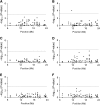Mapping regions within cosmopolitan inversion In(3R)Payne associated with natural variation in body size in Drosophila melanogaster
- PMID: 17603103
- PMCID: PMC2013698
- DOI: 10.1534/genetics.107.074336
Mapping regions within cosmopolitan inversion In(3R)Payne associated with natural variation in body size in Drosophila melanogaster
Abstract
Associations between genotypes for inversions and quantitative traits have been reported in several organisms, but little has been done to localize regions within inversions controlling variation in these traits. Here, we use an association mapping technique to identify genomic regions controlling variation in wing size within the cosmopolitan inversion In(3R)Payne in Drosophila melanogaster. Previous studies have shown that this inversion strongly influences variation in wing size, a trait highly correlated with body size. We found three alleles from two separate regions within In(3R)Payne with significant additive effects on wing size after the additional effect of the inversion itself had been taken into account. There were also several alleles with significant genotype-by-inversion interaction effects on wing size. None of the alleles tested had a significant additive effect on development time, suggesting different genes control these traits and that clinal patterns in them have therefore arisen independently. The presence of multiple regions within In(3R)Payne controlling size is consistent with the idea that inversions persist in populations because they contain multiple sets of locally adapted alleles, but more work needs to be done to test if they are indeed coadapted.
Figures


Similar articles
-
Parallel effects of the inversion In(3R)Payne on body size across the North American and Australian clines in Drosophila melanogaster.J Evol Biol. 2016 May;29(5):1059-72. doi: 10.1111/jeb.12847. Epub 2016 Mar 2. J Evol Biol. 2016. PMID: 26881839 Free PMC article.
-
The association between inversion In(3R)Payne and clinally varying traits in Drosophila melanogaster.Genetica. 2006 Sep-Nov;128(1-3):373-84. doi: 10.1007/s10709-006-7375-7. Genetica. 2006. PMID: 17028965
-
Patterns of diversity and linkage disequilibrium within the cosmopolitan inversion In(3R)Payne in Drosophila melanogaster are indicative of coadaptation.Genetics. 2006 Mar;172(3):1655-63. doi: 10.1534/genetics.105.053173. Epub 2005 Dec 1. Genetics. 2006. PMID: 16322502 Free PMC article.
-
Population genetics of inversion polymorphism in Drosophila ananassae.Indian J Exp Biol. 1998 Aug;36(8):739-48. Indian J Exp Biol. 1998. PMID: 9838874 Review.
-
Quantitative trait loci in Drosophila.Nat Rev Genet. 2001 Jan;2(1):11-20. doi: 10.1038/35047544. Nat Rev Genet. 2001. PMID: 11253063 Review.
Cited by
-
Genome-wide transcription analysis of clinal genetic variation in Drosophila.PLoS One. 2012;7(4):e34620. doi: 10.1371/journal.pone.0034620. Epub 2012 Apr 13. PLoS One. 2012. PMID: 22514645 Free PMC article.
-
Parallel effects of the inversion In(3R)Payne on body size across the North American and Australian clines in Drosophila melanogaster.J Evol Biol. 2016 May;29(5):1059-72. doi: 10.1111/jeb.12847. Epub 2016 Mar 2. J Evol Biol. 2016. PMID: 26881839 Free PMC article.
-
Patterns of geographic variation of thermal adapted candidate genes in Drosophila subobscura sex chromosome arrangements.BMC Evol Biol. 2018 Apr 24;18(1):60. doi: 10.1186/s12862-018-1178-1. BMC Evol Biol. 2018. PMID: 29699488 Free PMC article.
-
Genome-wide patterns of latitudinal differentiation among populations of Drosophila melanogaster from North America.Mol Ecol. 2012 Oct;21(19):4748-69. doi: 10.1111/j.1365-294X.2012.05731.x. Epub 2012 Aug 22. Mol Ecol. 2012. PMID: 22913798 Free PMC article.
-
Genetic mapping of adaptive wing size variation in Drosophila simulans.Heredity (Edinb). 2011 Jul;107(1):22-9. doi: 10.1038/hdy.2010.150. Epub 2010 Dec 15. Heredity (Edinb). 2011. PMID: 21157499 Free PMC article.
References
-
- Anderson, A. R., J. E. Collinge, A. A. Hoffmann, M. Kellett and S. W. McKechnie, 2003. Thermal tolerance tradeoffs associated with the right arm of chromosome 3 and marked by the Hsr-omega gene in Drosophila melanogaster. Heredity 90: 195–202. - PubMed
-
- Anderson, A. R., A. A. Hoffmann, S. W. McKechnie, P. A. Umina and A. R. Weeks, 2005. The latitudinal cline in the In(3R)Payne inversion polymorphism has shifted in the last 20 years in Australian Drosophila melanogaster populations. Mol. Ecol. 14: 851–858. - PubMed
-
- Andolfatto, P., F. Depaulis and A. Navarro, 2001. Inversion polymorphisms and nucleotide variability in Drosophila. Genet. Res. 77: 1–8. - PubMed
-
- Betrán, E., M. Santos and A. Ruiz, 1998. Antagonistic pleiotropic effect of second-chromosome inversions on body size and early life-history traits in Drosophila buzzatii. Evolution 52: 144–154. - PubMed
Publication types
MeSH terms
LinkOut - more resources
Full Text Sources
Molecular Biology Databases

